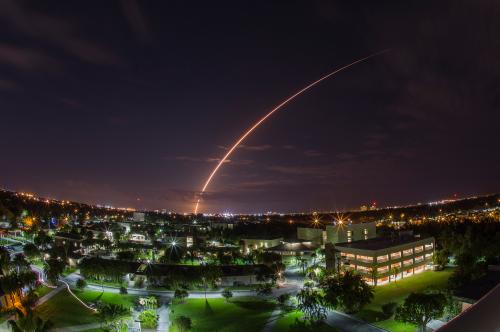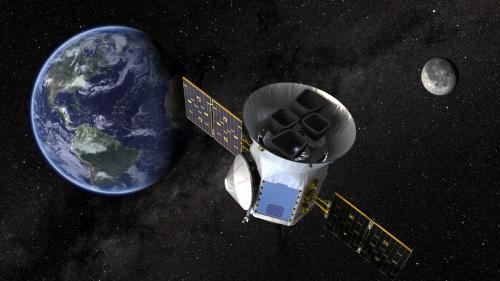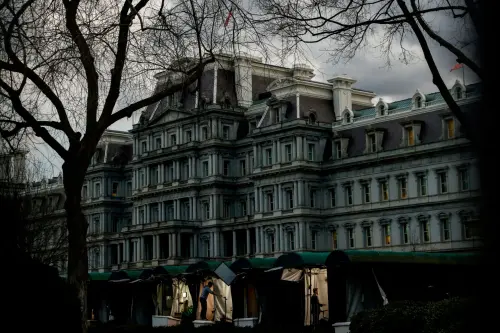Last year, much of the U.S. national security space community’s attention was focused on the Trump administration’s proposal to create a sixth military service, the Space Force, which would be responsible for training and equipping military space forces. While most experts agree that the changes in the threat environment, especially Russia and China’s development of anti-satellite weapons, require the United States to think differently about how we operate in space, no consensus has emerged as to whether creating a Space Force is the right solution to the problem.
However, in a December 18, 2018 speech at the Kennedy Space Center in Florida, Vice President Mike Pence announced that President Trump had signed an executive order establishing U.S. Space Command as the 11th combatant command in the U.S. military. Unlike the military services, which are responsible to training and equipping military forces, combatant commands provide command and control of military forces. Pence said that U.S. Space Command’s primary mission will be to “integrate space capabilities across all branches of the military. It will develop the space doctrine, tactics, techniques, and procedures that will enable our warfighters to defend our nation in this new era.” Establishing U.S. Space Command would be independent of a decision by Congress to create a Space Force.
While I have concerns about whether establishing a Space Force is the best way to address the growing threat to U.S. and allied space systems, there are many excellent reasons why the United States should re-establish U.S. Space Command.
Back to the future: U.S. Space Command 1985-2002
The idea of creating a U.S. Space Command is not new. Indeed, it was an active combatant command headquartered in Colorado Springs, Colorado from 1985 to 2002. Its overarching mission was to “coordinate the use of Army, Naval and Air Force space forces” and provide space-based missile warning, communications, navigation, weather, and imagery. For most of the command’s lifetime, the commander of U.S. Space Command served concurrently as the Commander for both North American Aerospace Defense Command (NORAD) and U.S. Air Force Space Command.
In 2002, U.S. Space Command was disbanded, and a the majority of U.S. Space Command’s missions were transferred to a “new” U.S. Strategic Command based at Offutt Air Force Base in Omaha, Nebraska. According to the Joint Staff’s History of the Unified Command Plan, the senior leadership of the Department of Defense believed that, “Technological advances were outpacing doctrine, particularly in global information operations, and a new STRATCOM could direct integrated global planning and execution to link strategic capabilities and the space domain.”
However, growing concerns about the threat to U.S. space systems led some in Congress to call for re-establishing U.S. Space Command. As a result, Section 1601 of the John S. McCain National Defense Authorization Act for Fiscal Year 2019, which became law on August 13, 2018, directed the Department of Defense, “to establish under the United States Strategic Command a subordinate unified command to be known as the United States Space Command for carrying out joint space warfighting operations.” But, unlike the congressional language, the executive order President Trump signed in December 2018 would create a stand-alone combatant command separate from U.S. Strategic Command.
The case for re-establishing U.S. Space Command
There are a number of compelling reasons for bringing back U.S. Space Command.
- The threat to U.S. and allied space systems continues to grow. Since 2002, the threat to U.S. and allied space assets has grown significantly. China’s January 2007 anti-satellite test against one of its own weather satellites, the Fengyun-1C (FY-1C), at an altitude of 863 km (534 mi), completely destroyed the satellite and was a wake-up call for many in the U.S. national security community about the threat to space systems for anti-satellite weapons. Director of National Intelligence Daniel Coats testified before the Senate Select Committee in February 2018: “Both Russia and China continue to pursue anti-satellite (ASAT) weapons as a means to reduce U.S. and allied military effectiveness…Military reforms in both countries in the past few years indicate an increased focus on establishing operational forces designed to integrate attacks against space systems and services.”
- U.S. Strategic Command’s span of control became too big for one combatant commander to effectively manage. From its stand-up in 1992, U.S. Strategic Command and its predecessor organization, Strategic Air Command, were primarily focused on the strategic nuclear deterrence mission. However, during the 2002 changes, U.S. Strategic Command picked up a number of new missions, including: global strike, missile defense, space, cyber, and combatting weapons of mass destruction. Given the increasing integration between the nuclear mission and other emerging domains, there was a strong argument for creating the “new” U.S. Strategic Command in 2002. But as time has gone by—and these emerging domains have continued to evolve—it has become clear that the magnitude of the challenge is too big for a single combatant commander to manage. As a result, over the past several years, U.S. Strategic Command has gradually shed some of the new missions like cyber (to U.S. Cyber Command), combatting weapons of mass destruction (to U.S. Special Operations Command), and now, space (to U.S. Space Command).
- U.S. Space Command will allow the U.S. military to develop more effective operational responses to the anti-satellite threat. Given the growing operational threats to U.S. and allied space systems, it is critical that the United States develop the tactics, techniques, and procedures to respond to the anti-satellite threat. Creating a stand-alone and focused operational command like U.S. Space Command will provide additional focus to more effectively achieve this goal.
- Re-establishing U.S. Space Command is cost-effective. Its foundation would likely be built using existing staff and resources currently in Colorado Springs. Though no official cost estimate has been released, a senior administration official estimated that creating the new command would likely cost about $800 million in new funding over the next five years, which would mainly go towards hiring about 1,000 additional staff. In the context of the U.S. defense budget, this represents a relatively minor cost. It also compares favorably with the costs of establishing a Space Force, which the Center for Strategic and International Studies estimates would costs between $1.5 billion and $2.7 billion in new funding over a similar five-year period.
Issues to consider going forward
While I support re-establishing U.S. Space Command, there are several considerations for the Trump administration and Congress.
First, it is imperative to ensure effective coordination and integration between U.S. Space Command, U.S. Strategic Command, and U.S. Cyber Command. As I noted in my June 21, 2018 testimony before the House Subcommittee on Terrorism, Nonproliferation, and Trade, the nuclear, space, and cyber domains are becoming increasingly integrated. Therefore, the administration and Congress need to think through how to ensure coordination between these three vital combatant commands. There are number of ways this could be accomplished. For example, the Department of Defense should consider establishing a senior level Strategic Deterrence Council, chaired by the deputy secretary of defense and vice chairman of the Joint Chiefs of Staff, to ensure coordination on cross domain deterrence issues across combatant commands.
Second, U.S. Space Command should ensure coordination with key allies and partners. A practical first step would be to establish liaison officer positions at the command for key allies. For example, a number of allied nations currently have liaison officers assigned to U.S. Strategic Command; establishing similar positions at U.S. Space Command should not be difficult. In the long term, the command should examine ways to better integrate allies into the development of space doctrine, tactics, techniques, and procedures to improve the United States’ ability to operate more effectively with allies.
Third, the administration and Congress should consider whether the commander of U.S. Space Command should be dual-hatted to also serve as the commander of Air Force Space Command. There are both pros and cons to this approach, but it’s something that should be examined.
Finally, while the Trump administration should certainly receive credit for focusing national-level attention on the importance of space, its approach has been too focused on developing purely military solutions to this problem and has largely neglected diplomacy. Deterring threats to U.S. and allied space systems will require the United States to develop a comprehensive strategy of which a key element must be diplomacy. There are several relatively simple actions the Trump administration should take to steer U.S. space diplomacy back on track.
[The Trump administration’s] approach has been too focused on developing purely military solutions to this problem and has largely neglected diplomacy.
For example, the administration could reinvigorate the United States’ bilateral space security discussions with our allies and partners. During the Obama administration, the United States conducted over 20 bilateral space security dialogues. These engagements helped build understanding of the threat, assisted with the coordination of multilateral diplomatic initiatives, and facilitated opportunities for practical cooperation on things like hosted payloads and space situational awareness. To date, the Trump administration’s efforts in this area have been limited.
The administration should also resume the bilateral space security dialogues with Russia and China. In the past, these dialogues provided the United States an effective forum to send clear and direct messages to both nations. Given the current tensions in the bilateral relationships with both countries, having forums where the United States can deliver blunt messages is of particular importance. Such forums can also provide opportunities to advance cooperative initiatives where appropriate. For example, the Obama administration used its bilateral dialogues with Russia and China to advance cooperative efforts to mitigate problems posed by orbital debris.
And lastly, as I have written elsewhere, the United States should continue its efforts to develop norms of behavior for outer space to help manage an increasingly congested, competitive, and contested space environment.
In conclusion, the growing threat to U.S. and allied systems from countries like Russia and China requires the United States to think differently about how it operates in space. Re-establishing U.S. Space Command will help the United States respond effectively to that challenge. That said, as the new combatant command is formed, Congress and the administration need to ensure that it’s done in a way that encourages effective integration with other key combatant commanders (e.g., U.S. Cyber Command and U.S. Strategic Command), and enables the United States to operate more effectively with allies in space. They should also remember that the United States will need a comprehensive strategy that employs all elements of its national power, including diplomacy, to effectively respond to the emerging threat to U.S. and allied space systems. Military efforts alone will not be sufficient to maintain a safe, secure, and stable outer space environment.
The Brookings Institution is committed to quality, independence, and impact.
We are supported by a diverse array of funders. In line with our values and policies, each Brookings publication represents the sole views of its author(s).










Commentary
Re-establishing U.S. Space Command is a great idea
January 7, 2019